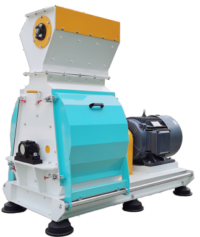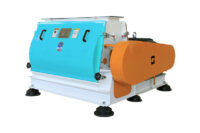Talk about feed mill factory
Depending on the type of raw materials, the packaging form, and the means of transportation used, different raw material receiving processes are adopted. Regardless of the receiving process, the quality and weight inspection of the raw materials are required. The raw material receiving process is briefly described as follows.
(1) Receiving raw materials from bulk trucks and tankers (mostly grains and by-products from processing) that enter the factory, and are automatically discharged into the receiving pit after being weighed by the weighbridge. The car receiving pit should be equipped with a fence, which can protect personal safety and remove large impurities. The grid gap is about 40mm. A suction hood is required at the receiving pit, and the wind speed is 1.2-1.5m/s to reduce dust. After the raw materials are discharged into the receiving pit, they are sent to the vertical silo for storage or directly into the smashing silo or batching silo (no need to pulverize powdery auxiliary materials) through the horizontal conveyor, bucket elevator, magnetic separator and automatic scale.
(2) Pneumatic conveying and receiving It can absorb raw materials from automobiles, tankers and ship silos, and is especially suitable for receiving raw materials from ship silos. The pneumatic conveying device consists of suction nozzles, feed pipes, unloaders, air shutters, dust collectors, and fans. And other composition. Under the action of the wind of the fan, the suction device sucks the material into the unloader from the ship silo, and the separated material is discharged into the subsequent conveying device by the air shutter. The pneumatic conveying device can be divided into two types: mobile and fixed. Generally, large-scale feed mills should adopt fixed ones, and small-scale feed mills can adopt mobile ones. The advantages of the pneumatic conveying device are clean material suction, less dust, simple structure, convenient operation and low labor intensity. The disadvantage is that the energy consumption is higher than other mechanical conveying.
(3) There are two types of receiving in bags: manual receiving and mechanical receiving.
1. Manual reception is the use of manpower to move the bagged materials from the conveying tool into the warehouse, stacking, unpacking and feeding, with high labor intensity, low production efficiency and high cost.
2. The machine receives the car or train to transport the bagged raw materials into the factory, which is manually moved to the belt conveyor and transported into the warehouse, and then stacked by the machine. Or the bag is lifted from the car or the ship by a crane, and then transported into the warehouse by a fixed belt conveyor for stacking. Mechanical receiving has high production efficiency and low labor intensity, but large investment in disposable feed equipment.
(4) Reception of liquid raw materials The most liquid raw materials received by feed mills are molasses and fat. When liquid raw materials are received, they must first be inspected. The main contents of the inspection are: color, smell, specific gravity, concentration, etc. Raw materials that have passed the inspection can be unloaded and stored. Liquid raw materials need to be shipped in barrels or tankers. The barreled slag can be moved by truck or forklift into the warehouse. When the tanker is shipped, the tanker enters the factory, and the receiving pump configured by the factory pumps the liquid raw materials into the storage tank. The storage tank is equipped with a heating device, and the liquid raw materials are heated first during use, and then pumped to the workshop for addition.
We will talk more about feed mill. send us inquiry to Whatsapp +86 153 7309 2014.
www.chinafeedmill.com





Leave A Comment